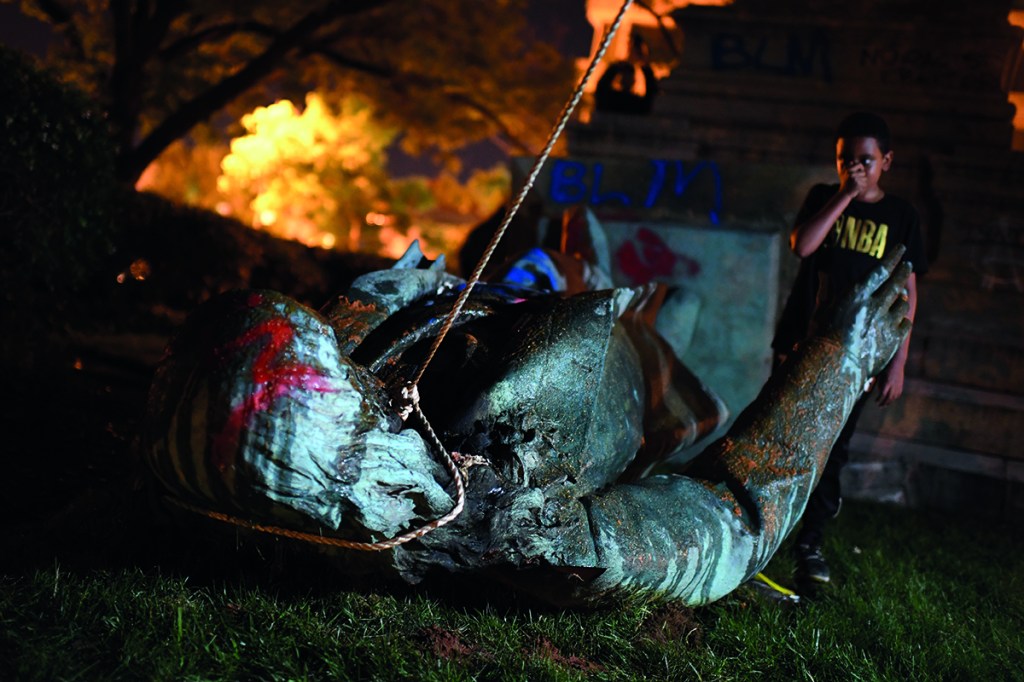In a speech to the Federalist Society in November, Supreme Court Justice Samuel Alito reiterated his concern that ‘in certain quarters, religious liberty is fast becoming a disfavored right’. Small wonder that the subject was on his mind. A week earlier, the Court had heard oral arguments in the latest religious-liberty case, Fulton v. City of Philadelphia. In it, Catholic Social Services — one of some 30 agencies used by the city to place foster children in private homes — claimed religious exemption for its policy of placing kids in traditional mom-and-dad family settings.
So far, one might think, so unremarkable: a Catholic agency conforms its good works to Catholic principles. But what about nontraditional couples — like those of the same sex? As it happens, CSS was not approached by any such couples looking for kids — likely because all the other 30 agencies are available to them. In fact, CSS would even refer same-sex couples to those other agencies, if needed. Thus far, at least, Philadelphia seems to have enjoyed a live-and-let-live solution to a pluralist polity in which diverse points of view coexist. No one appears to have suffered from CSS’s policies, and many kids seem to have been helped.
So why did Philadelphia stop referring foster children to CSS, thus prompting the suit that has put this case before the Court? As Justice Alito observed sharply, ‘If we are honest about what’s really going on here, it’s not about ensuring that same-sex couples in Philadelphia have the opportunity to be foster parents. It’s the fact [that] the city can’t stand the message that Catholic Social Services and the archdiocese are sending by continuing to adhere to the old-fashioned view about marriage.’ Justice Brett Kavanaugh, too, remarked upon the aggression of CSS’s adversaries. Philadelphia, he observed, was ‘looking for a fight’ in ceasing its referrals.
Welcome to 2020, and one more woke effort to put a Christian charity out of business.
The Philadelphia case joins a growing list in which do-gooding by Certain People has been punished with financially and otherwise draining lawsuits — even when, as in Fulton v. City of Philadelphia, the harm to anyone is nonexistent. The Little Sisters of the Poor have been dragged through the courts for years, deposed and otherwise menaced, even though their alleged social crime — objecting to being forced to provide contraception — has not impeded a single soul, then or now, from locating all manner of such devices across the land. Masterpiece Cakes in Colorado and Memories Pizza in Indiana were similarly hounded for refusing to participate in same-sex weddings — even though none of the antagonistic parties were at risk of lacking pizza or cakes, or anything nuptial at all following Obergefell v. Hodges.
Such cases ignite the suspicion that people today are being harassed in courts because they are believing Christians. As Rod Dreher summarizes in his new book, Live Not by Lies: A Manual for Christian Dissidents:
‘[A] progressive — and profoundly anti-Christian — militancy is steadily overtaking society… [It] takes material form in government and private institutions, in corporations, in academia and media, and in the changing practices of everyday American life… There is virtually nowhere left to hide.’
Like Dreher, other concerned observers tend to focus on what this new animus is doing to the faithful. I would like to ask a different question that will also shape their future, and for that matter, everyone else’s: where is this new animus coming from?
After all, it’s not as if social conservatism directs the traffic. Same-sex marriage has been legal for five and a half years. For all the affrighted talk of handmaids, abortion on demand continues at an uninterrupted clip. Hollywood, Silicon Valley and almost every humanities faculty in the land are monuments to the Confederacy of Woke. So are many American corporations. So, especially, is Big Tech. The churches themselves, riven by long-running civil wars over the sexual revolution, are nowhere playing offense. So what is really goading all those sign-toting foot soldiers in yoga pants and skinny jeans?
Entrenched bureaucracy is one culprit. Like Teddy Brewster in Arsenic and Old Lace, who doesn’t understand that the battle for San Juan Hill has been over for some time, today’s alphabet activists continue charging… somewhere. Yesterday’s advocates for same-sex marriage, far from packing up and going home, make new demands — such as that accreditation be removed from Christian schools, say, or that biological boys be forced onto sports teams for biological girls. True, these agendas are antinomian and un-American. But they are also the fruit of something more prosaic: mission creep.
Eyeing the signs of the times, however, one suspects that a more seismic answer to the question of today’s animus against Christians and their works may also be in order, and that it relates to the implosion of the traditional western family. The American family has changed radically during the past 60 years. Less than one fifth of households now conform to the ‘nuclear family’ model of mother, father and children. In 1960, that number was 45 percent.
The American family has also shrunk: children today are considerably less likely to have siblings — and by extension, cousins, aunts and uncles — than they were 60 years ago. Almost 30 percent of all households consist of just one person. Some 40 percent of all children lack a biological father in the home.
Such momentous, ubiquitous changes to the elemental structures of kinship have had, and continue to have, momentous and ubiquitous consequences. How could they not? Some of these outcomes — such as the connections between disrupted homes on the one hand and childhood and adolescent dysfunction on the other — have been mapped well by sociologists and related experts for several decades now. At the same time, as 2020 demonstrated repeatedly, one large terra incognita comes into clearer focus every day: a world like ours, in which many people have fewer and weaker family ties, is a world in which many people are furious about things they do not have or no longer know.
Consider as Exhibit A the seemingly bizarre outpouring on the left that greeted the nomination of Justice Amy Coney Barrett to the Supreme Court. ‘An anti-choice fanatic with seven kids,’ ran a typical slur on Salon. Her confirmation hearing was ‘child-obsessed’ and used ‘children as talking points’, showcasing Barrett’s ‘prolific motherhood’, complained the Washington Post. Activists for the new racialism, including Ibram X. Kendi, cast ugly aspersions on the fact that two of the Barretts’ children had been adopted from Haiti. Beneath the ultimately ineffectual sniping, the collective gasp was practically audible. Seven kids? Who does that?
This brings us back to the implosion of the family, which has left many contemporary people without access to some basic human goods. This is especially evident on the secular left. By now, generations of American women have been raised to fear their own fertility, and to see life as a zero-sum game in which babies equal career cancellation. By dint of her mere example, Justice Barrett gave those people the shock of their lives. And by raising, however tacitly, the forbidden thought that families and professional accomplishment might be workable together after all, her example no doubt set off other unwanted notions, long suppressed — including about families and their importance, period.
In sum, beneath the snark about the Barretts ran two unmistakable currents: first, that a great many people on the progressive side are now ignorant of an elementary human reality — namely, that there are families with more than one or two kids; and secondly, that a lot of woke women, in particular, were moved to fury at the mere sight of a mom of several. What is fury, but the flip side of loss?
Or consider another example of how the hunger for connections once supplied by family is revealed in politics: the BLM-driven protests and riots that roiled cities across the country throughout 2020.
Sparked by the death of George Floyd and outrage about police brutality, and doused throughout with the incendiary Marxism-anarchism of BLM, the protests morphed throughout the summer and fall into something very different from protest as usual: a national theater in the round via nightly news, exhibiting before the world what the waning of family and community is doing to some of America’s young. The fact that hefty numbers of these souls bear little responsibility at home was evident, first, just by watching television.
Who, after all, is able to attend protests night after night for months on end, as in Portland? For the most part, not people living in families; and certainly not fathers and mothers who live with young children. Biographies of some of the actors in particular tragedies bear out the point. Consider the profile of the shootings in Kenosha, Wisconsin during a demonstration on August 25. The shooter lived with his single mother. The friend who obtained a firearm for him lived with a stepfather. Two of the three men who were shot, and who were regulars at the downtown protests, were raised in single-parent homes. Two of the protesters also had children of their own and were not married. And so on.
Similar biographical strands can be found in other stories of disengaged young men with disproportionate attractions to groups that operate as family substitutes — whether street gangs, BLM or identitarian groups of the right or left. Consider one case from 2019 in Eugene, Oregon. There, a young man was shot and killed by police at his daughter’s middle school, in the midst of a custody dispute. He was carrying a gun and had an extra clip in his belt. A veteran, he was divorced from his wife, after which he became involved with a series of activist groups on and off his college campus. These included Latino and LGBTQ organizations, as well as a community for self-defense that trained people in firearm use. By the end of his short life, he was also using the pronouns ‘they/them’.
Depending on one’s politics, his tragic story could be interpreted variously as a cautionary tale about trauma in wartime; or about the ease of obtaining firearms; or about police bias against sexual minorities. But surely its primordial caption would be: a severing from family, followed by identity dissolution that ended in violence.
***
That familial loss had something to do with the 2020 protests is also revealed by some of BLM’s obnoxious theatrics: shining flashlights into families’ homes, waking families in the middle of the night by screaming, and disrupting outdoor meals. These last misanthropic forays are not surprising tactics for BLM. They have by now a substantial history in the United States. #BlackBrunch, a similar set of movements that has also aggressively interrupted diners in cities around the country, began more than five years ago in Oakland. The stated purpose of these intrusions is to invade ‘traditionally white spaces’ to raise awareness of black suffering.
But what is specifically ‘white’ about dining out? More telling is what is being disrupted here. Overwhelmingly, people dine out with family and friends — their smallest and dearest communities. In the rage caught on video after video this summer, another possibility for the origin of these disruptions emerges: resentment of those who enjoy their social and familial ties. Why else would anyone exult in upending one of life’s universal pleasures: time alone in a relaxed setting with loved ones and friends?
As the phrase ‘protest families’ signals, other details also suggest that some of the discontent out there has familial roots. Douglas Murray reported of Portland that protesters taunted cops with the chant ‘Your children will hate you’. What kind of political statement is that, if not one of rage against people who do have families? And, of course, across the United States, furious mobs toppled monuments of past leaders — not just those of Confederates, but of anything that looked like a male authority figure, including Mahatma Gandhi. Tearing down a Confederate statue is a political statement. Tearing down statues of men indiscriminately is a daddy issue.
And it is here that the family-deprived, untethered mobs of 2020 intersect indelibly with the new animus against Christianity. For this year was not only remarkable on account of BLM and other unrest in the streets. The discontent brought with it a stunning rise in attacks on churches and other religious structures across the country, as the United States Conference of Catholic Bishops summarized in a press release expressing the alarm of many at this increase in vandalism and desecrations.
At least 37 incidents occurred across 20 states since June 22. The cause of one, the fire at Mission San Gabriel Arcángel in the Archdiocese of Los Angeles, is still unknown. Incidents include arson; statues beheaded; limbs cut, smashed and painted; gravestones defaced with swastikas and anti-Catholic language and American flags next to them burned; and other examples of destruction and vandalism. The full list of particulars ran to six and a half closely spaced pages, every one of which raises the question: why churches?
After all, if the protests were about racism, it is hard to see the benefit of attacking houses of worship — especially the Catholic Church, some of whose clergy were on the front lines of the civil rights movement; whose schools in the inner city and elsewhere are among the surest tickets to a better life for many kids; and whose global hierarchy and laity include representatives of every shade of melanin known to nature.
The answer can only be that, as the most visible remaining defenders of the traditional family, the churches are natural lightning rods for the fury and woe that a social order deprived of robust family ties will inevitably produce.
***
The temptation to look elsewhere abounds. In a piece for the Atlantic last year announcing that ‘The Nuclear Family Was a Mistake’, David Brooks acknowledges that America’s kinship implosion has unleashed ‘an epidemic of trauma’, especially among the worse-off. Even so, he argues, the time has come to drop the illusion that Mom, Pop, and the kids could ever be all right. He lauds the vogue for ‘chosen families’, meaning ‘the rise of new living arrangements that bring nonbiological kin into family or family-like relationships’.
Such forged familial identities may be rewarding to consumerist adults. But their appeal to the most vulnerable members of society (children, say) seems problematic. The notion that boys or girls thrive around males to whom they are not biologically related is overruled by generations of social science about the risks of just that. Beyond such empirical cautions lie matters of the heart. What child, given the choice, would prefer a ‘chosen family’ to his very own?
‘Chosen families’, like street gangs and other identitarian bands, are mothered by the necessity of human nature: if families cannot exist, their simulacra must be invented. That’s why substitutes for kin have proliferated in the decades since the sexual revolution took off. All are part of the ongoing, post-1960s transfer of social capital, according to which more and more of it accrues to the strongest members of society, leaving the weakest even more vulnerable than before.
This brings us to the grittiest truth not only of 2020, but of the future it foretells. Much of America now roams the nation and the internet in search of family substitutes: street gangs, ‘chosens’, identitarian groups, BLM and toxic ideologies. And none of these alternatives is remotely up to the job done by the functioning real thing — or even the semi-functioning real thing. The new American ‘haves’ are those who have managed, through luck or hard work or both, to maintain vigorous family ties despite it all. The new have-nots are those who suffer from these primal losses, and who latch with increasing desperation on to collective, victim-centered ‘identities’.
In an age that’s increasingly illiterate about all things Christian, and that no longer believes in sins, deadly or otherwise, capital vices like anger and envy may go unnoticed. Likely that’s why the affliction of the increasingly disconnected is chronically misdiagnosed, even as it rumbles in the streets. But the excuse of our myopia does not make family loss in post-1960s America any less explicable — or any less of a tragedy.
This article was originally published in The Spectator’s January 2021 US edition.

























